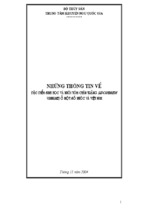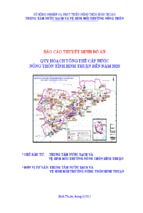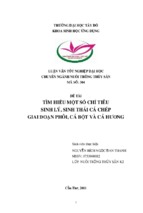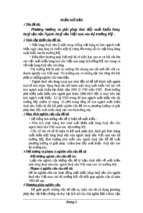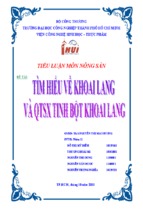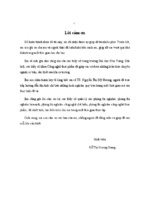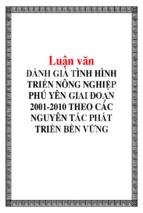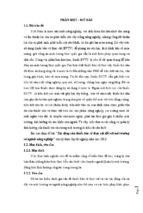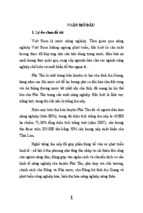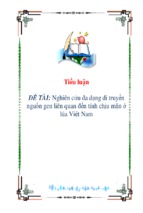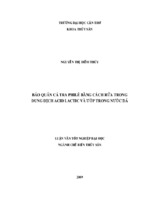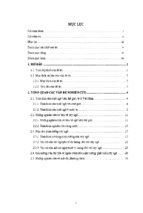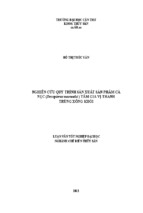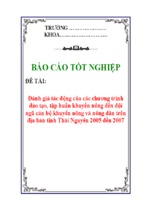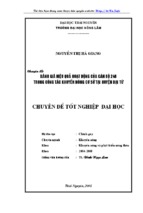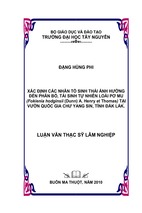VIET NAM NATIONAL UNIVERSITY OF AGRICULTURE
FACULTY OF AGRONOMY
UNDERGRADUATE THESIS
Genetic variability, heritability and expected selection gain of quantitative
traits in F5 progenies of soybean biparental cross
SUPERVISOR
:
Assoc. Professor. Dr. Vu Dinh Hoa
DEPARTMENT
:
Plant Genetics and Breeding
STUDENT
:
Nguyen Thi Thuy Hang
CLASS
:
Advanced Crop Science 57
STUDENT CODE :
575832
HANOI - 2016
CONTENT
ACKNOWLEDGEMENT.........................................................................................
CONTENTS..............................................................................................................
LIST OF ACRONYMS.............................................................................................
PART 1: INTRODUCTION.............................................................................................1
1.1. Introduction..................................................................................................................1
1.2. Objective and requirement...........................................................................................2
PART 2: LITERATURE REVIEW................................................................................3
2.1. Classification, origin, and distribution of soybean.......................................................3
2.2. World soybean production and Usage...........................................................................
2.3. Soybean production in Vietnam and usage....................................................................
2.4. Nutritional Values and benefits of soybean
2.4.1. Nutritional Values
2.4.2. Helth of benefit of soybean
2.5. Soybean breeding
2.6. Variability and quantitative traits
PART 3: MATERIALS AND METHODS........................................................................
3.1. Experimental Materials
3.2. Cultural practices
PART 1: INTRODUCTION
1.1.
Introduction
Soybean [Glycine max (L.) Merr.] is an important crop cultivated worldwide for its
high nutritional value such as protein content (35-40 %), oil content (15-20%) and
as food for both human and feed for livestock. Soybean originated in China, and
spread to many countries such as Asia, United States, Brazil, India, Argentina,
Europe.
Soybean is a leguminous crop that creates an environment as home to symbiotic
bacteria Rhizobium that fixes atmospheric nitrogen and convert it to ammonia for
the growing plant to manufacture amino acids, proteins, and nucleic acids. This
ability has proven to be beneficial to production soybean.
In the last decades, soybean breeding has developed a great number of new
varieties that contribute to sustainable and profitable agriculture. Higher yields,
early maturity and valuable traits contribute to agricultural productivity in several
agro-ecological regions in Vietnam. Farmers grow over 190,000 hectares with an
average grain yield of 1.5 tones/ha in 2010. Howver, facing with global climate
change, soybean varieties must be targeted to specific geographic areas to suit local
growing conditions such as soils, temperature, and rainfall are the primary factors
controlling yield in soybean. Thus soybean breeding is tailored to selecting highyielding varieties that are adaptable to subotimal conditions.
Most characters of economic importance in soybean are quatitative traits, including
yield, protein content, plant height and maturity. The improvement of quantitative
traits is effected by environment and breeding methods. The methodologies for the
selection of parents and crosses with a high genetic potential to produce superior
populations now allow a more precise choice of potential parents in relation to
quantitative traits (Gomes et al., 2004).
The success of selection depends largely on genetic variability of the
poppulation under consideration. If the heritability and coefficient of variation for
the characters are high, then selection progress becomes easier and thus response to
selection will be greater.
Being a self-fertilized crop, the inherent variability of
soybean is very much circumscribed. In most soybean breeding program, the
genetic variability is created by conventinal method of hybridization. Thus, the
estimations of different genetic parameters such as genetic variation and
heritability would provide information about the traits’ variability. Furthermore,
heritability of a quantitative trait is very important to the breeder, enabling the
estimation of heritable portion of the total phenotypic variation, the choice of
selection methods, and in determining the response to selection because it implies
the extent of transmissibility of traits to the next generation.
Therefore, the estimation of genetic paramters of the segregating progenies
derived from crosses is of great significance to direct the breeding process and
selection gain through selecting most desirable genotypes.
1.2. Objectives and requirements
1.2.1. Objectives
- To estimate the manitude of genetic variability/heritability for quantitative
traits of F5 generation of soybean populations and
- To determine the genetic advance through selection from segregation progeny
1.2.2. Requirement
- Evaluate some quantitative charactes of soybean in Summe-Autumn season
2016.
- Assess the growth and development of soybean in Summer-Autumn season
2016.
PART 2: LITERATURE REVIEW
2.1. Classification, origin, and distribution of soybean
Soybean is polyploid origin due to high chromosome number, it includes diploid
and tetraploid nature ( 2n = 40 or 4n = 40 ) in the family Leguminousae, and the
genus Glycine and, scientific name is Glycine max (L.) Merrill. Many species are
diverse in morphology, the number of chromosomes and grow in different climate
and soil condition and have geographic distribution.
The soybean ( G.soja) is found throughout China, its distribution in China is most
extensive, its diversity of types the richest, its number the largest. Over 11 th century
B.C., Chinese Emperor Sheng Nung wort Material Medica – the first record of
soybean cultivation. In that record, soybean were note as being valued for their
medicinal purpose. Soybeans were first cultivated in northern China. From there,
their uses spread into Japan, Korea. Soybean have been an important source of
food for over 4500 years ago. Glycine max is found the first in the west by
Swedish botanist.
During the first haft 20th century, China was the world’s largest soybean producer
and exporter. But in the 1950s, 1960s, and 1970s, soybean production developed
rapidly in USA, Brazil, Argentina.
The areas where soybeans are mainly grown range from cold temperate-climate
regions (Northern U.S. and Canada) to tropical regions (Indonesia). Temperatures
between 22 and 35°C are prime for its growing season, and can affect its flowering
dates.
2.2. World soybean production and Usage
During the last decades, World soybean production and usage of soybean is
slightly fluctuated from 175.2 million metric tons in 2000 to 324.2 million metric
tons in 2016 ( figure 1 ). Today, most of the world’s soybeans are processed or
crushed into soybean meal and oil (Ali 2010). It is estimated that 2% of soybean
production is consumed by humans directly as food (Goldsmith 2008).
Graph 1: World soybean production and Usage
Soybean oil is used in cooking oil, bio-diesel fuel, so on. Cooking oil made from
soybeans is low in saturated fat and is used to help reduce fat and lower cholesterol
in our diets. Diesel fuel made from soybean oil is biodegradable, sulfur-free, does
not produce explosive vapors and emits a much lower amount of pollutants.
2.3. Soybean production in Vietnam and usage
Vietnam’s soybean area has increased, production is very small. Soybean
production is around 160 – 250 thousand tonnes per year, and crop yields are low,
between
1-1.5 metric tons/ha. In Vietnam, most of soybean production is
consumed as human consumption in the form of soy sauce, tofu products, and
soymilk. Only a small quantity of lower quality soybean is used for animal food.
Vietnam imports some soybeans for the livestock feed. According to goverment,
Vietnam imports approximately 200 - 800 thousand tons, mainly from USA,
China.
Graph 2: Vietnam’s soybean imports (2009-2013)
2.4. Nutritional Values and benefits of soybean
2.4.1. Nutritional Values
The soybean seeds contain high quantity of protein and its amino acid composition
is approximate to composition of animal proteins, therefore is often used as
replacement component of meat protein. Soybean seeds are used in oil industry.
About 90% of soybean seeds make up cotyledons and 8% there are hulls. In the
cotyledons are accumulated proteins and fats , the main components of seeds. In
the cotyledons also are accumulated carbohydrates and anti-nutritional factors. In
result of separation of this components or their extraction were obtained different
soybean products used in people and animals feeding.
Nutrients
Amount
Vitamins
Amount
Minerals
Amount
Proteins
Water
Ash
68 g
15.9 g
9.1 g
Vitamin A
Vitamin C
Vitamin E
41 IU
11 mg
1.6 mg
Phytosterols
299 mg
Vitamin K
87 mcg
830
224
Thiamin
Riboflavin
Niacin
1.6 mg
1.6 mg
3 mg
334
271
Vitamin B6
Folate
701 mcg
698 mcg
Calories
Total Calories
Calories From
Carbohydrates
Calories From Fats
Calories From
Proteins
Carbohydrates
Total Carbohydrates
Dietary Fiber
Sugar
Fats & Fatty Acids
Total Fat
Saturated Fat
Monounsaturated
Fat
Polyunsaturated Fat
Omega-3
Fatty
Acids
Omega-6
Fatty
Acids
56 g
17 g
14 g
37 g
5.4 g
8.2 g
21 g
2.5 g
18 g
Pantothenic Acid 1.5 mg
Choline
216 mg
Betaine
3.9 mg
Calcium
Iron
Magnesiu
m
Phosphoru
s
Potassium
Sodium
Zinc
515 mg
29 mg
521 mg
Copper
Manganes
e
Selenium
3.1 mg
4.7 mg
1.3 g
3.3 g
3.7 mg
9.1 mg
33 mcg
2.4.2. Health benefits of soybean
Soybeans are an important source of not only proteins, but carbohydrates, fats, and
many essential vitamins and minerals. So, they facilitate normal growth and
development in young children. They can help manage the level of cholesterol,
blood sugar and body fats, when consumed in adequate quantities. They are often
regarded as an ideal food for those trying to build muscles. They can be of
immense help for preventing a number of health problems, including
atherosclerosis or hardening of the arteries and complications related to the heart.
Even people suffering from diabetes can receive significant health benefits from
consuming soybeans. Oil obtained from soybeans is very rich in essential fatty
acids like linoleic and linolenic acids. Both are very important for human health, as
they help regulate blood pressure and facilitate the absorption of vital nutrients. So,
soybeans are an extremely beneficial food that can provide almost all the important
nutrients required for human growth and development. They are quite popular for
being a rich as well as a cheap source of proteins.
2.5. Soybean breeding
Soybeans are one of the major crops in the Viet Nam and the world. The soybean
quality and production is increased by the genetic improvement. In the recent, like
most selft-fertilized, soybean breeders are producing cultivars using traditional
conventional breeding methods.
High yield is the main objective of breeding programs. Grain yield is the most
important quantitative character in breeding of soybean, depending on both the
genotypic potential and environmental conditions of soybean growing. Essentially,
all of the genetic gains in soybean yield have been achieved by traditional breeding
methods, involving hybridisation and phenotypic selection (CORYELL et al.,
1999). Grain yield is a complex trait and consists of components of quantitative
nature, whose expression is determined by genetic and environmental factors as
well as their interactions. Therefore, plant breeders need to observe genetic
variability, environmental variability and variability of their interaction.
2.6. Variabilty and Quantitative traits
The examination of genetic variability is important for plant breeders in general
and particularly in introduced crops like soybean. Introgression of diverse
germplasm into the current soybean genetic base may increase genetic variability
and lead to grater gains from selections (Thomson and Nelson 1998). Studying the
soybean germplasm for its genetic variability and to evaluate the interaction of
environment and variabilites. Quantitative characters which are of economic value,
highly influenced by environmental condition, progress of breeding in such
characters are primarily conditioned by the magnitude and nature of variation and
interrelationships among them. Success in crop breeding is also depend on the
isolation of genetically superior genotypes based on the amount of variability
present in the materials. Therefore, information on genetic variability existed in a
group of populations of soybean is essential. Hence, the present study was initiated
to determine components of phenotypic variation, heritability, genetic advance,
nature and magnitude of association of different traits and direct and indirect effect
of various traits towards seed yield.
PART 3: MATERIALS AND METHODS
3.1. Plant Materials and cultural practices
Thirty three F5 families soybean derived from the single cross of VI45032 × 4904/1,
Will be arranged in a randomized copmplete block design with three replications. Seeds
of each F5 family and the parents will be sown in double row plots of 1.5 square meters.
Plant spacing was 40 cm x 15 cm. Quantitative traits are measured from 20 – 30 random
individual plants of each plot were recorded, and depend on the number of seed from F 4
generation. There are the experiment layout
LSB10-1-16
LSB10-2-14
LSB10-3-4
LSB10-3-6
LSB10-3-11
LSB10-4-11
LSB10-4-19
LSB10-4-20
LSB10-4-25
LSB10-14-4
LSB10-14-11
LSB10-14-18
4904/1
LSB10-22-11
LSB10-22-10
LSB10-22-5
LSB10-20-8
LSB10-16-20
LSB10-16-13
LSB10-16-2
LSB10-15-20
LSB10-15-17
LSB10-15-10
LSB10-15-8
LSB10-15-6
125/1
Border row
LSB10-28-10
LLSB10-28-21
LSB10-30-13
LSB10-31-16
LSB10-33-7
LSB10-13-22
125/1
4904/1
LSB10-1-16
LSB10-2-14
LSB10-3-4
LSB10-3-6
LSB10-13-22
Border row
LSB10-15-17
LSB10-15-10
LSB10-15-8
LSB10-15-6
LSB10-14-18
LSB10-14-11
LSB10-14-4
LSB10-4-25
LSB10-4-20
LSB10-4-19
LSB10-4-11
LSB10-3-11
LSB10-33-7
LSB10-15-20
LSB10-16-2
LSB10-16-13
LSB10-16-20
LSB10-20-8
LSB10-22-5
LSB10-22-10
LSB10-22-11
LSB10-28-10
LLSB10-28-21
LSB10-30-13
LSB10-31-16
Fertilizer will be applied with 500 kg of organic fertilizer, 60 kg N, 40 kg P 2O5 and 90
kg K2O on hectare basis. Cultural practices such as irrigation, weeding and pest control
will be done as needed.
3.2. Data collection
Ten randomly selected plant from double row of each plot were used to record data.
Morphological characteristics
Sprout Stem Color
Leave Shape
Flower Color
1-green
2-purple
3-green purple
1-tria-angle
2-egg-shaped acute
1-white
2- purple
Stem’s pubescence density
1-thick
2-thin
Pubescence color
Growth Type
Pod Color
Seed shape
Seed color
Hilum color
3.2. Cultural practices
No.
Flower color
F5 families
plant
White
Purple
Leave shape
Egg-pointed
Triangle
1
2
3
4
5
6
7
8
9
10
11
12
13
14
15
16
17
18
19
20
21
22
23
24
25
26
28
28
29
30
31
32
LSB10-1-16
LSB10-2-14
LSB10-3-4
LSB10-3-6
LSB10-3-11
LSB10-4-11
LSB10-4-19
LSB10-4-20
LSB10-4-25
LSB10-14-4
LSB10-14-11
LSB10-14-18
LSB10-22-11
LSB10-22-10
LSB10-22-5
LSB10-20-8
LSB10-16-20
LSB10-16-13
LSB10-16-2
LSB10-15-20
LSB10-15-17
LSB10-15-10
LSB10-15-8
LSB10-15-6
LSB10-28-10
LSB10-28-21
LSB10-30-13
LSB10-31-16
LSB10-33-7
LSB10-13-22
125/1
4904/1
31
16
19
18
17
19
27
18
22
13
16
5
15
13
10
10
15
19
16
17
10
16
12
26
34
15
4
17
7
26
31
14
19
18
17
14
21
18
19
13
16
5
15
13
10
0
12
14
1
17
10
16
12
26
34
15
4
17
7
21
0
2
0
0
0
5
6
0
3
0
0
0
0
0
0
10
3
5
15
0
0
0
0
0
0
0
0
0
0
5
31
16
19
18
17
19
27
18
22
13
16
5
15
13
10
10
15
19
16
17
10
16
12
26
34
15
4
17
7
26
41
41
0
41
0
0
0
0
0
0
0
0
0
0
0
0
0
0
0
0
0
0
0
0
0
0
0
0
0
0
0
0
0
0
0
0
- Xem thêm -

